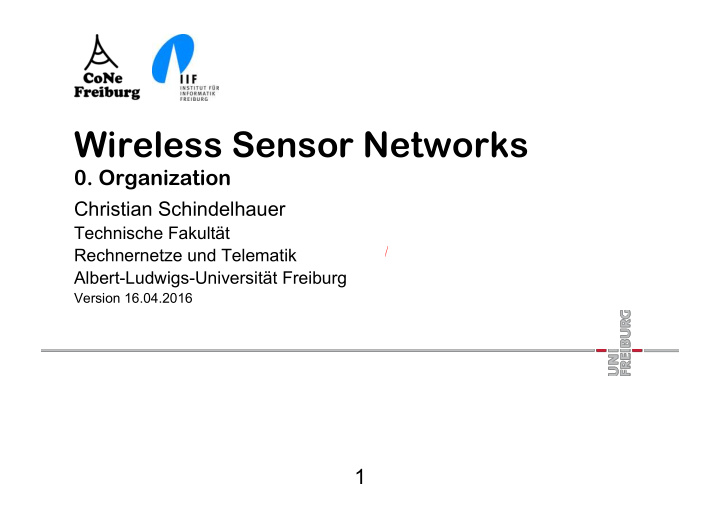



Wireless Sensor Networks 0. Organization Christian Schindelhauer Technische Fakultät Rechnernetze und Telematik Albert-Ludwigs-Universität Freiburg Version 16.04.2016 1
Organization � Web page - http://cone.informatik.uni-freiburg.de/lehre/aktuell/wsn-ss16 � Forum - http://archive.cone.informatik.uni-freiburg.de/forum3/viewforum.php?f=46 - for discussions, remarks, critics, funnies, etc. � Lecture - Lecturers: • Christian Schindelhauer (mostly) • Johannes Wendeberg (localization) - Monday, 14:15-16:00, room 101-01-009/013 - Wednesday, 08:15-09:00, room 101-01-009/013 � Exercises - Tutors: • Amir Bannoura • Joan Bordoy - wednesday, 09:15-20:00, room 101-01-009/013 - starts 27.04.2016 2
Contents - Wireless Sensor Networks � Basics - Wireless Communication - Computer Networks - WSN technologies - Case studies � Physical Layer � Medium Access � Routing � Data aggregation � Sensor coverage � Energy & Lifetime � Resilience � Localization - ToA, TDOA, RSSI, Cell-based, anchorless 3
Exam � Oral exam � 30 minutes � Questions form - lectures - exercises � closed book exam � Exam registration online 4
Web Page - http://cone.informatik.uni-freiburg.de/lehre/ aktuell/wsn-ss16 � Slides � Exercises � Recordings � General information 5
Literature • Ilyas, Mahgoub, Handbook of Sensor Networks: Compact and Wired Sensing Systems, CRC Press • Agrawa, Zeng, Introduction to Wireless and Mobile Systems, Thomson, 2003 • Schiller, Mobile Communications, Addison-Wesley, 2000 • Karl, Willig, Protocols and Architectures for Wireless Sensor Networks, Wiley, 2005 • Zhao, Guibas, Wireless Sensor Networks – An Information Processing Approach, Morgan Kaufmann, 2004 • Wu, Handbook on Theoretical and Algorithmic Aspects of Sensor, Ad Hoc Wireless, and Peer-to-Peer Networks • Boukerche Handbook of Algorithms for Wireless Networking and Mobile Computing, CRC 2005 • research papers from the field • more to be announced 6
Wireless Sensor Networks 1. Basics Christian Schindelhauer Technische Fakultät Rechnernetze und Telematik Albert-Ludwigs-Universität Freiburg Version 17.04.2016 7
Organization � Web page - http://cone.informatik.uni-freiburg.de/lehre/aktuell/wsn-ss16 � Forum - http://archive.cone.informatik.uni-freiburg.de/forum3/viewforum.php?f=46 - for discussions, remarks, critics, funnies, etc. � Lecture - Lecturers: • Christian Schindelhauer (mostly) • Johannes Wendeberg (localization) - Monday, 14:15-16:00, room 101-01-009/013 - Wednesday, 08:15-09:00, room 101-01-009/013 � Exercises - Tutors: • Amir Bannoura • Joan Bordoy - Wednesday, 09:15-20:00, room 101-01-009/013 - starts 27.04.2016 8
Networks Types � Cellular networks - one or more access stations - each access station covers a cell - e.g. mobile telephones, WLAN � Mobile ad hoc networks - self-configuring network of mobile nodes - nodes serve as end-points or routers - without any dedicated infrastructure � Wireless sensor network - connecting sensors and actuator units wireless communicating with one or more base stations - base station is more powerful than other nodes 9
Some Relevant Wireless Networks � GSM (Global System for Mobile Communications) GPRS (General Packet Radio Service) EDGE (Enhanced Data Rates for GSM Evolution) - Smartphones, PDAs, Laptop/netbook, Tablets, Phablets � UMTS (Universal Mobile Telecommunications Systems) HSDPA (High Speed Downlink Packet Access) - 3rd generation mobile communication standard � LTE (Long Term Evolution) - 4th generation standard � IEEE 802.11 a/b/g/n/ac – Wi-Fi (Wireless Fidelity) – Wireless Local Area Network (WLAN) - computers, cameras, printers � Bluetooth (IEEE 802.15.1) - several version, Bluetooth v4.0, Bluetooth low energy 10
Some Relevant Wireless Networks � IEEE 802.15.4 + Zigbee - Wireless Personal Area Network (WPAN) - Wireless sensor networks - Zigbee Alliance • defined higher protocol layers � DECT ULE (Digital Enhanced Cordless Telecommunications Ultra Low Energy) - adapted standard for cordless phones � Low-Power Wide-Area Network (LPWAN) - LoRaWAN (Long Range Wide Area Network) � Narrow-Band Internet of Things (NB-IOT) - narrowband radio technology specially designed for the Internet of Things (GSM/LTE) � … 11
ISO/OSI Reference model � 7. Application - Data transmission, e-mail, terminal, remote login � 6. Presentation - System-dependent presentation of the data � 5. Session - start, end, restart � 4. Transport - Segmentation, congestion � 3. Network - Routing � 2. Data Link - Checksums, flow control � 1. Physical - Mechanics, electrics 12
Data/Packet Encapsulation Stevens, TCP/IP Illustrated 13
Example Stacks The Internet of Every Thing - steps toward sustainability CWSN Keynote, Sept. 26, 2011 14
Example Stacks 15
Physics – Background � Moving particles with electric charge cause electromagnetic waves - frequency f : number of oscillations per second • unit: Hertz - wavelength λ : distance (in meters) between two wave maxima - antennas can create and receive electromagnetic waves - the transmission speed of electromagnetic waves in vacuum is constant - speed of light c ≈ 3 ⋅ 108 m/s � Relation between wavelength, frequency and speed of light: λ ⋅ f = c 16
Electromagnetic Spectrum guided media twisted pair coaxial cable optical waveguide fibre Hz 10 9 10 11 10 13 10 15 10 3 10 5 10 7 low high infrared micro wave medium frequency frequency visible frequency radio TV light unguided media 17
Bands � LF Low Frequency � MF Medium Frequency � HF High Frequency � VHF Very High Frequency � UHF Ultra High Frequency � UV Ultra Violet light 18 Picture under creative commons license http://creativecommons.org/licenses/by-sa/2.5/
Recommend
More recommend